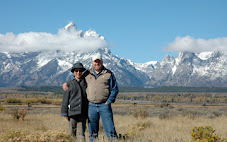If you're wondering why it's called Sheep Creek, this is probably the answer. These are baby bighorn sheep.
Here's the mama keeping an eye out for danger in between munches on the roadside grasses.
Driving through the Sheep Creek Geological Area and walking to Big Spring.
I hope I don't mix up these labels. If I'm correct, this is the Uinta Mountain Group, which was laid down between 2 billion and 500 million years ago. Notice the rocks, which would have been laid flat originally, are almost vertical from uplifting.
Madison limestone, about 350 millions years old.
This tree is not prehistoric, but it must be one tough little conifer.
This is Tower Rock, which is Weber sandstone, about 280 million years old.
This is the road through the Sheep Creek Geological Area. There are also a lot more formations that I didn't post here.
Moving on to Flaming Gorge, this is a tree that was hit recently by lightning at the Red Canyon overlook. The rest of the tree is lying to the right side.
This is driving over the bridge just prior to the Flaming Gorge Dam.
The Red Canyon portion of Flaming Gorge.
An overlook near Dutch John.
Hunting near the reservoir.
Also from the overlook near Dutch John.
This is Flaming Gorge Reservoir, the main body.













No comments:
Post a Comment